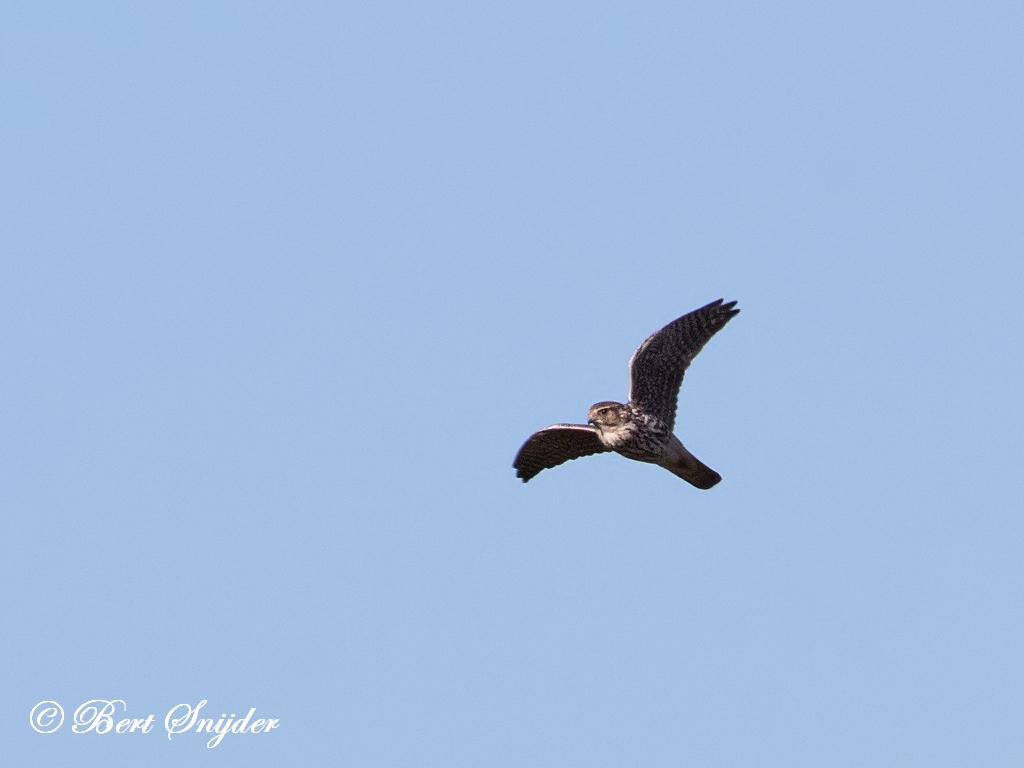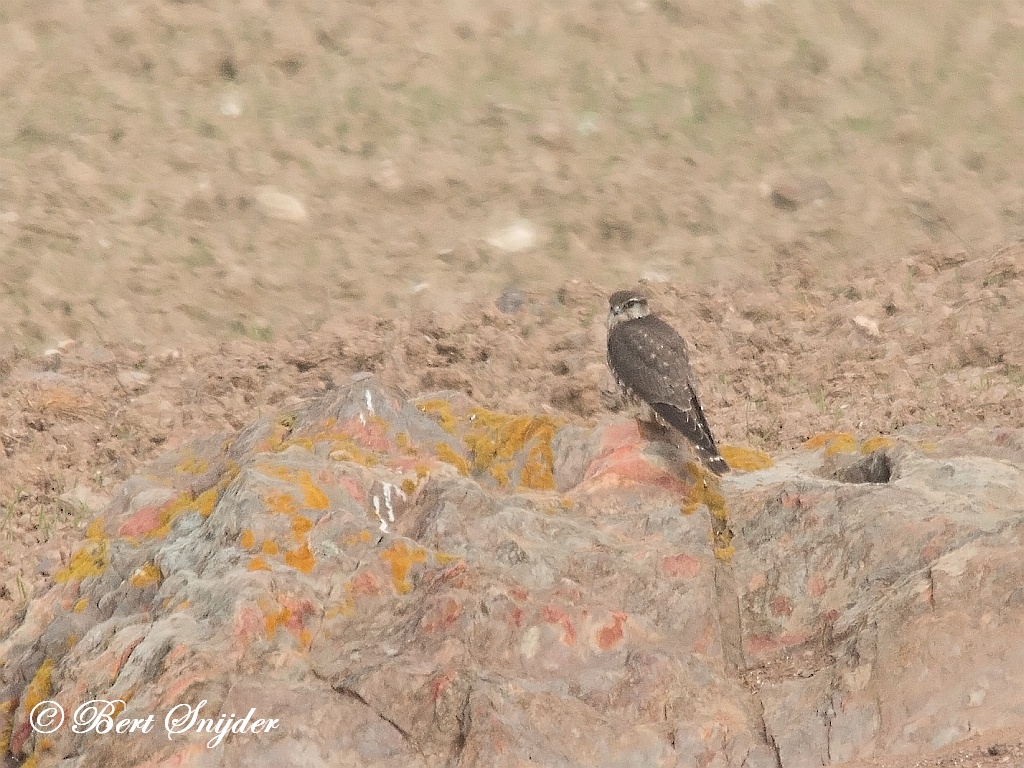Spotted in the Alentejo region of Portugal. Merlin sound
The Merlin (Falco columbarius) is a small species of falcon from the Northern Hemisphere, with numerous subspecies throughout North America and Eurasia. A bird of prey once known colloquially as a pigeon hawk in North America, the Merlin breeds in the northern Holarctic; some migrate to subtropical and northern tropical regions in winter. Males typically have wingspans of 53–58 centimetres (21–23 in), with females being slightly larger. They are swift fliers and skilled hunters who specialize in preying on small birds in the size range of sparrows to quail. The Merlin has for centuries been well regarded as a falconry bird. In recent decades Merlin populations in North America have been significantly increasing, with some Merlins becoming so well adapted to city life that they forgo migration.

More photos at the bottom of this page.
Merlins inhabit fairly open country, such as willow or birch scrub, shrubland, but also taiga forest, parks, grassland such as steppe and prairies, or moorland. They are not very habitat-specific and can be found from sea level to the treeline. In general, they prefer a mix of low and medium-height vegetation with some trees, and avoid dense forests as well as treeless arid regions. During migration however, they will utilize almost any habitat.
Most of its populations are migratory, wintering in warmer regions. Northern European birds move to southern Europe and North Africa, and North American populations to the southern United States to northern South America. In the milder maritime parts of its breeding range, such as Great Britain, the Pacific Northwest and western Iceland, as well as in Central Asia, it will merely desert higher ground and move to coasts and lowland during winter. The migration to the breeding grounds starts in late February, with most birds passing through the USA, Central Europe and southern Russia in March and April, and the last stragglers arriving in the breeding range towards the end of May. Migration to winter quarters at least in Eurasia peaks in August/September, while e.g. in Ohio, just south of the breeding range, F. c. columbarius is typically recorded as a southbound migrant as late as September/October. In Europe, Merlins will roost communally in winter, often with hen harriers (Circus cyaneus). In North America, communal roosting is rare.
Merlins rely on speed and agility to hunt their prey. They often hunt by flying fast and low, typically less than 1 m (3.3 ft) above the ground, using trees and large shrubs to take prey by surprise. But they actually capture most prey in the air, and will “tail-chase” startled birds. Throughout its native range, the Merlin is one of the most able aerial predators of small to mid-sized birds, more versatile if anything than the larger hobbies (which prefer to attack in mid-air) and the more nimble sparrowhawks (which usually go for birds resting or sleeping in dense growth). Breeding pairs will frequently hunt cooperatively, with one bird flushing the prey toward its mate.
The Merlin will readily take prey that is flushed by other causes, and can for example be seen tagging along sharp-shinned hawks (Accipiter striatus) to catch birds that escape from this ambush predator into the open air. It is quite unafraid, and will readily attack anything that moves conspicuously. Merlins have even been observed trying to “catch” automobiles and trains, and to feed on captive birds such as those snared in the mist nets used by ornithologists. Even under adverse conditions, one in 20 targets is usually caught, and under good conditions almost every other attack will be successful. Sometimes, Merlins cache food to eat it later.




Other synonyms:
Arabic: الشاهين الصغير, اليؤيؤ, اليؤيؤ أسود الذيل, اليؤيؤ أسود الذيل شويهين
Asturian: Zaperín
Azerbaijani: Derbnik, Ördəktutan
Belarusian: Сокал-дрымлюк
Bulgarian: Малък сокол, Сокол чучулигар
Breton: Ar falc’hun moan
Catalan: Esmerla, Falconet
Catalan (Balears): Esmerla
Valencian: Falconet
Montenegrin: mali soko
Creoles and Pidgins, French-based (Other): gli-gli moutayn
Czech: døemlík tundrový, Dremlík tundrový, Dřemlík tundrový
Welsh: Bod glas, Corgwalch, Corwalch, Cudyll bach, Cudyll glas bach, Gwalch bach, Gwalch y grug
Danish: Dværgfalk
German: Merlin, Zwergfalke
Greek: Νανογέρακο, Νανοφάλκονο
Greek (Cypriot): Νανοφάλκονο
English: Merlin, Pigeon Hawk, Stone Falcon
English (IOC): Merlin
Esperanto: Kolombfalko
Spanish: Emerillon, Esmejerón, Esmerejon, Esmerejón, Falcón Migratorio, Halcón Esmerejón, Halcón Migratorio, Halcón palomero, Halconcito, Halconcito de Palomas
Spanish (Colombia): Esmerejón
Spanish (Costa Rica): Esmerejón
Spanish (Cuba): Halconcito de Palomas
Spanish (Dominican Rep.): Emerillon, Halconcito, Merlin
Spanish (Ecuador): Esmerejón
Spanish (Spain): Esmerejón
Spanish (HBW): Esmerejón
Spanish (Honduras): Halcón palomero
Spanish (Mexico): Esmerejón, halcón esmerejón
Spanish (Nicaragua): Esmerejón
Spanish (Panama): Merlín
Spanish (Peru): Halcón Esmerejón
Spanish (Puerto Rico): Falcón Migratorio
Spanish (Venezuela): Halcón Migratorio
Estonian: Väikepistrik
Basque: Belatz txiki, Belatz txikia, Esmerla
Persian: ترمتای معمولی
Finnish: Ampuhaukka
Faroese: Smiril, Smyril
French: Faucon émerillon, Faucon kobez
Irish: Meirliún
Guadeloupean Creole French: Gligli, Grigri
Gaelic: Mèimeal, Mèirneal
Galician: Esmerillón, Esmerla, Falcón pequeno
Manx: Shawk veg
Haitian Creole French: Grigri Mòn
Hebrew: בז גמד, בז גמדי
Croatian: Mali Sokol, Soko kraguljčić
Hungarian: Kis sólyom
Armenian: [Aghavnabaze ], Աղավնաբազե
Icelandic: Smyrill
Italian: Smeriglio
Japanese: ko chōgenbō, Ko-chogenbo, Ko-choogenboo, kochougembou, kochougenbou, Ko-chougenbou
Japanese: コチョウゲンボウ
Japanese (Kanji): 小長元坊
Georgian: ალალი
Kazakh: Жағалтай, Тұрымтай
Kazakh (Transliteration): turımtay
Korean: 쇠황조롱이
Korean (Transliteration): soe-hwang-jorongi
Cornish: Falghun meyn
Scientific: Falco colombarius, Falco columbarius, Falco columbarius columbarius
Luxembourgish: Merlin
Lithuanian: Paprastasis startsakalis, Startsakalas, Startsakalis
Latvian: Purva piekūns, Purva vanadziņš
Macedonian: Мал сокол
Mongolian: Хайргана шонхор, Хайргууна шонхор
Mongolian (Bichig): ᠬᠠᠢᠢᠷᠠᠭᠣᠨᠠ ᠱᠣᠩᠬᠣᠷ
Mongolian (Bichig, Inner Mongolia): ᠬᠠᠢᠢᠷᠠᠭᠣᠨᠠ ᠱᠣᠩᠬᠣᠷ
Mongolian (Cyrillic, Inner Mongolia): Турамтай начин, Хайргууна шонхор, Харнүдэн
Mongolian (Transliteration): khairgan shoŋkhor, khairguun shoŋkhor, khar-nüdeŋ, turamtai nachiŋ
Moldavian: Șoim de iarnă
Maltese: Seqer ta’ Denbu
Dutch: Smelleken
Norwegian Nynorsk: Dvergfalk
Norwegian: Dverfalk, Dvergfalk, Steinfalk
Polish: drzemlik
Pinyin: huī-bèi sǔn, huī-bèi zhǔn
Portuguese: Esmerilhão
Portuguese (Brazil): Esmerilhão
Portuguese (Portugal): Esmerilhão
Romansh: Falcun merlin
Romanian: Şoim de iarnă
Russian: Derbnik, Дербник
Scots: Meimeal
Sindhi: س ڇَسبي ډٮم ڃًي
Northern Sami: Cizašfálli
Slovak: sokol kobe, Sokol kobec
Slovenian: mali sokol
Albanian: Skifteri i vogël
Serbian: mali soko, soko, Мали соко
Swedish: Stenfalk
Thai: เหยี่ยวเมอร์ลิน
Thai (Transliteration): yìaw moee-lin
Turkish: Boz doğan, Boz Doşan, Güvercin Doğanı, Тұрымтай
Tuvinian: Бора хокпештээр шаңгыр
Ukrainian: Дербник, Малий підсоколик, Підсоколик малий
Vietnamese: Cắt lưng xám, Chim Cắt lưng xám
Chinese: [hui-bei sun], [hui-bei zhun], 灰背隼
Chinese (Traditional): 灰背隼
Chinese (Taiwan, Traditional): 灰背隼
Chinese (Taiwan): [hui-bei zhun], 灰背隼
Birders Birdwatching Holiday in the Alentejo region of Portugal, Individual guided tours, trips, excursions and birding holiday.